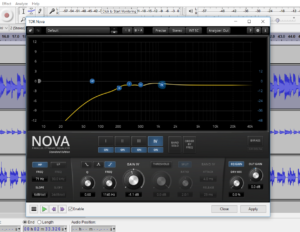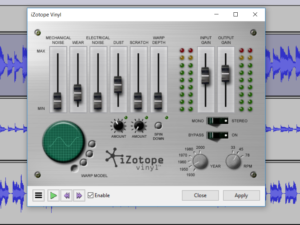I Don’t Mind (Sea Piglet, 2017)
I Don’t Mind (Sea Piglet, 2017)
Hi! Welcome to Studia, my third soon-to-be defunct blog on this site. In this one, I will write a little bit about the recording and mixing of each song I work on after it’s gone out into the world, whether it’s my own solo thing, a friend’s music I’ve recorded/”produced,” or something from my Scottish/Irish band, Dòrain. Hopefully it’ll be a narrative of continuous learning and improvement, since I’ve only just this year gotten over ten years of saying, “I can’t learn how to do this – I don’t understand technical things – I don’t have ‘that kind of brain.'” Now I’m trying to learn everything I can while putting it into practice making the best music I can.
This is a song by my friend Beki, who records under the name Sea Piglet. She’s become a prolific songwriter out of almost nowhere, and I’ve been having a lot of fun recording her songs; this one was recorded in my little bedroom studio when my recording stuff was all crowded into a small bedroom with all my other worldly possessions.
We recorded the piano into Audacity (I use Audacity instead of a proper DAW; more on that later, maybe) with the two audio outputs from my roommate’s piano going to the two inputs of my Focusrite 2i4 interface. I have a Thing about MIDI that I should probably get over at some point, so right now I always just record the audio from the keyboard. Fortunately, my roommate’s keyboard sounds really good. After that we recorded Beki’s vocal with my best available mic, my Rode NTK tube condenser. I’m not sure this is the best mic for Beki’s voice (though her voice sounds fantastic no matter what.) I tried a different, non-tube condenser (borrowed from my roommate) on her recently and I think I liked it better.

Free VST plugins like TDR Nova make Audacity a lot more powerful.
After that, Beki left and I was left to my own devices to flesh the song out. My brother added ukulele (recorded with the Rode) and I added bass, guitars and shakers. I own and attempt to play a beautiful acoustic-electric bass guitar that has a pickup but also a lovely acoustic sound to it, so the way I usually try to capture it is a two-pronged approach. I plug the bass into the Focusrite interface to record a DI, but then also put the Rode mic on it to capture the acoustic sound, string noise and whatnot. I split the DI part into two parts, one low-passed to be just the low frequencies, the other high-passed to be everything else; the mic signal is also high-passed so the lows from the DI stand alone. (During mixing I decide if I want to use the higher part of the DI, or just the mic sound and the lows.) On some songs I do just the DI, when I want less of an acoustic bass sound, but for most of Sea Piglet’s songs I want that feel.
For the guitars and shakers I just recorded through an unassuming SM57, which I felt clever about (for the guitars). I had nicer mics available, but I didn’t really want the guitar to shine and sparkle and cut through, but just unobtrusively fill things out. I ended up pretty happy with the choice.
I won’t say much about the mixing, I think – it’s safe to say that I used the TDR Kotelnikov compressor and/or the TDR Nova dynamic EQ on pretty much everything, because those plugins are so versatile and high-quality. The one thing is obviously worth commenting on – I had the silly idea to copy and paste Beki’s singing from the very end to the intro, and make that section sound like an old record or radio transmission. I put the vocals through an aggressive high-pass and low-pass filter (the “telephone effect”) and compressed it like hell, then ran the whole section through iZotope Vinyl, a free plugin from a company that also makes quite expensive plugins, which makes things sound like an old record – you have a dial to pick the era of records you’re imitating, and sliders for factors like wear, dust, and scratches. The amusing thing is that iZotope also sells the tools to get rid of all those types of artifacts – of course the company that specializes in audio cleanup/restoration also knows how to put all the dirt and wear back in. Putting it in is so much easier than taking it out that they don’t even charge for it.

IZotope Vinyl for the “old record” feel.
Well – we’ll call that a blog post. I’m not 100% sure what the audience for this is meant to be, and if I should explain all the things/equipment/techniques I mentioned in passing up there. Let me know, maybe?
July 4, 2017 @ 4:54 pm
Dig it! I’m also teaching myself audio production basics/running a tiny recording studio for myself, mainly. It’s nice to see your thought process here. It’d be fun to have more posts like this, where you do a debriefing/analysis of a project you’ve completed, or problems you’ve encountered and figured out solutions to.
July 5, 2017 @ 9:54 pm
Thanks! I’m planning on just doing a recap like this of each song I work on as they get released, and maybe pick an element each time to go into a little more depth about.
July 4, 2017 @ 7:02 pm
Yay! It never even occurred to me that there would be plug-ins for this sort of thing but of course there would. I’m pretty entertained that a plugin exists solely for making things sound old and even scratchy. Sometimes the world we live in is a magical place.
And thanks for all that nice stuff too I guess! 😀